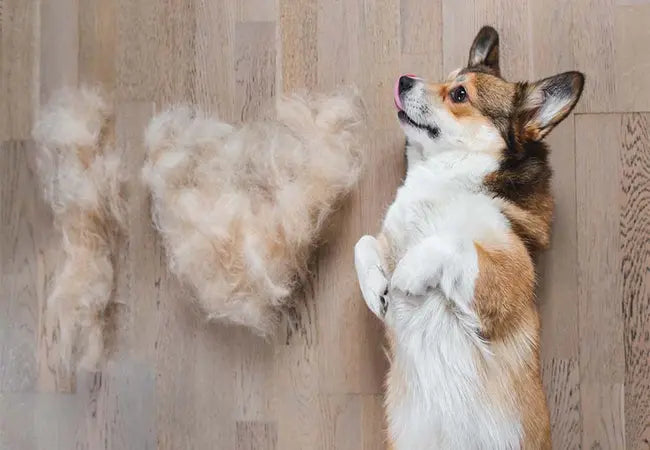Excessive Shedding in Dogs: Veterinary Guide & Care Tips 2025 🩺🐾

In this article
Excessive Shedding in Dogs: Veterinary Guide & Care Tips 2025 🩺🐾
By Dr. Duncan Houston BVSc
Hi, I’m Dr Duncan Houston BVSc, veterinarian and founder of Ask A Vet. If your home is turning into a fur tumbleweed zone, excessive shedding might be more than just a nuisance—it could point to dietary imbalance, allergies, parasites, stress, or other health issues. In this 2025 guide, you’ll find expert advice to understand, assess, and manage shedding—from what’s normal to what requires a vet visit, with tools from Ask A Vet. 🐶💙
1. What Is Normal vs Excessive Shedding?
All dogs shed—that’s how they renew their coat. Seasonal molts (spring/fall) are expected, especially in double-coated breeds. But sudden increases, dull coat, or skin changes (bald spots, irritation) may signal an underlying issue.
Breeds that shed heavily:
- Labrador Retrievers, German Shepherds, Huskies—known as “heavy shedders”
- Varies by climate and indoor lighting—artificial light can disrupt natural shedding cycles
2. Common Causes of Excessive Shedding
2.1 Seasonal Molt
- Occurs twice yearly—spring and autumn—as dogs adapt to temperature and daylight shifts.
- Expect heavier shedding during these peaks; normal outside of them is concerning.
2.2 Nutrition & Diet Quality
- Poor-quality food lacking protein, essential fatty acids (omega‑3 & 6), vitamins, minerals—most common cause of dull coat and shedding.
- Hydration matters—dry skin sheds more.
2.3 Allergies & Food Intolerance
- Food, environmental, or flea allergies cause itching, infection, and shedding.
- Look for other signs—scratching, redness, hotspots, ear infections.
2.4 Skin Parasites & Infections
- Fleas, mites, and lice—itching leads to hair loss.
- Fungal or bacterial infections also cause patchy shedding.
2.5 Stress & Anxiety
- Change in routine, new home, and separation anxiety can trigger shedding.
- Frequent grooming of stressed dogs exacerbates hair loss.
2.6 Hormonal Disorders & Illness
- Thyroid issues, Cushing’s disease, diabetes—cause hair thinning, shedding.
- Systemic diseases (kidney, liver, autoimmune, cancer) may contribute.
3. 🩺 Assessment & When to See Your Vet
- Watch for coat changes: dullness, dryness, bald patches, scaling, redness.
- Other symptoms: itching, weight changes, sickness, lethargy, appetite loss.
- Vet diagnostics: skin scrape, fecal check, blood panels (thyroid, adrenal, kidney, liver), allergy testing.
If shedding coincides with ill health signs, call your vet promptly.
4. Treatment & At‑Home Care
4.1 Nutrition & Supplements
- Upgrade to vet-recommended diet high in protein, omega-3/6 fats.
- Consider fish oil, biotin, vitamin A/C/E, zinc, and MSM for coat health.
4.2 Grooming Routine
- Brush 2–3 times/week for short hair; daily for thick/long coats. Use undercoat rake or slicker where needed.
- Bath monthly or during shedding peaks; use gentle, dog-safe shampoo.
4.3 Manage Allergies & Parasites
- Switch diets if allergies are suspected; give antihistamines or prescribed meds.
- Maintain year-round flea/tick control.
4.4 Reduce Stress
- Provide predictable routines, training, play, and mental enrichment.
- Consider behavioral consults or calming supplements from Ask A Vet.
4.5 Address Medical Conditions
- Treat thyroid disorders, Cushing’s, or systemic disease as diagnosed by the vet.
- Antimicrobial or antifungal therapy for skin infections.
5. Tools: Ask A Vet 💡
- Ask A Vet: Teleconsults for diagnosing coat issues, allergy guidance, and stress protocols.
6. Monitoring & Prevention
- Record shedding, coat quality, and weight every month.
- Track allergen exposure, stress events, and season changes.
- Schedule annual wellness visits for bloodwork and parasite checks.
7. 🏥 When to Seek Immediate Help
- Sudden, patchy, or severe hair loss.
- Bald, crusted, or infected-looking skin.
- Sick dog with itchiness, weight loss, lethargy.
- New lumps or systemic signs during shedding spike.
8. Final Thoughts 📝
🧠 Shedding is natural, but excessive loss often reflects internal health, nutrition, stress, or allergy issues. By combining veterinary care, quality diet, grooming habits, and wellness monitoring, with tools like Ask A Vet, you can help your dog grow a healthier, happier coat in 2025 and beyond. 🐾💙
Worried about shedding? Book a telehealth check on AskAVet.com and start tracking your. Together, we’ll bring back that glossy shine! 🌟


